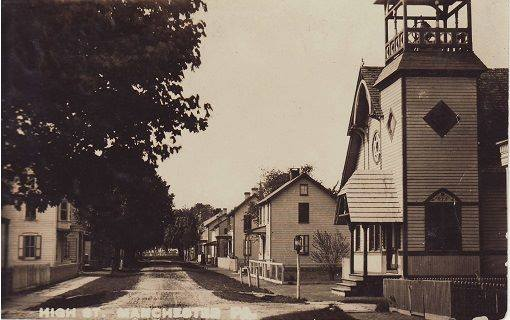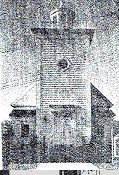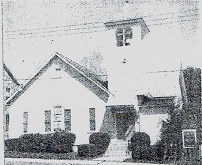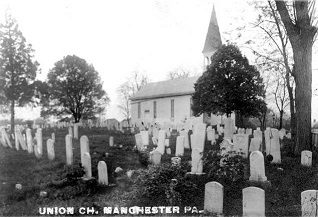

Before Manchester Borough
North Eastern York County History In Preservation NeyChip
“The Borough is situated on land that was obtained by John Nickey in 1740, an heir of William Penn. In 1814, William Reeser purchased the land noting its proximity to the Susquehanna River and markets in the south... Its beginning was unique, Resser felt it would make an ideal site for a town. So he decided to conduct a lottery. First, he divided his land into 100 lots and sold 100 tickets at $100.00 each. Reeser hired Daniel Small, of York, to lay out a portion of the tract into a town.
According to historians, crowds overflowed to the borders of the town on the day of the lottery. Everyone who purchased a ticket received a portion of the land. The drawing merely decided which parcel of the land the ticket holder would receive.
Reeser made a profit of $500.00 and in 1816 he built a large brick mansion at the angle formed by the turnpike and York Road... In January 1825, Marquia de Lafayette stopped at the home of Reeser on his way to Harrisburg…. The history books say many years prior to 1885, the Resser mansion was turned into a hotel. A man named Flury turned it into a store in the early 1900’s, probably about 1904. Samuel Schroll, Jr. took over the store in the 1920’s. The Schroll family operated the store until the late 1950’s. It was then used as the family home until 1986. [At that time, the building was razed and a service station for Atlantic Refining company was build. It is known today as Wise Auto Repair. See article.]
Originally, Manchester was named Liverpool. Thirteen years after the town was laid out, on February 13, 1827, the Manchester Post Office was established… Reeser was appointed the first postmaster. The town and the Post Office continued to have different names until August 27, 1869, when the borough was incorporated. At that time the name was charged from Liverpool to Manchester. The name was changed at that time because there was a town named Liverpool in Perry County."
In June 28, 1863, General Jubal Early dispatched Colonel William H French's 17th Virginia Cavalry to burn two Northern Central Railway bridges over the Conewago Creek. The troopers followed what is today Church Road to reach Board Road. They headed through the village of Liverpool Post Office. About 400 Union soldiers had been encamped on Col Hoff's farm, to guard these bridges but they crossed over the Susquenhanna during the early morning, fearing the approach of a large army. A few shots were fired at the last boat load by the Confederates. Forty years later, Michael Gross spoke with historian George R. Prowell about the area's reaction to this event. See Manchester resident recalled Rebel invasion.
The First Union Church was built and dedicated on January 21, 1822, in front of the Union Cemetery. It was sponsored by the Presbyterians and Lutherans.of York. In 1832, it became a regular appointment for the United Brethren in Christ. This log Union Church was used until it was torn down in 1880. The St Paul United Brethren Church moved to High Street. The Second Union Church was build that year on the same location and used by the Evangelicals. This building was used until 1902 when the St Paul Evangelical Church moved to Cooper Street. The Second Union Church was razed in 1954 The only thing still remaining are the steps leading up to the previous location of the church and the Veteran's Memorial now stands in its place.
For many years, the two congregations, now just a block apart, would attend each other services. The one would have services in the morning and the other in the afternoon. In 1946, the two denominations merged to become the Evangelical United Brethren Church. At that time, St Paul Evangelical Church changed their name to Albright Evangelical United Brethren Church. Then on Easter Sunday 1956, the two churches merge and became one.
"In 1857, the Lutherans built Christ Lutheran Church on its present site on South Main Street…[It is the only remaining church in the Borough limits.] Two other churches, one on High Street and the other on Cooper Street joined together to build St. Paul United Methodist Church on Board Road [just outside the Borough]. Both buildings now serves as an apartment houses... The original school building in the area was the old Mennonite Meeting House, just north of the town. The Mennonite Meeting House is still standing, on its present site. It is still being used as a church.”
According to historians, crowds overflowed to the borders of the town on the day of the lottery. Everyone who purchased a ticket received a portion of the land. The drawing merely decided which parcel of the land the ticket holder would receive.
Reeser made a profit of $500.00 and in 1816 he built a large brick mansion at the angle formed by the turnpike and York Road... In January 1825, Marquia de Lafayette stopped at the home of Reeser on his way to Harrisburg…. The history books say many years prior to 1885, the Resser mansion was turned into a hotel. A man named Flury turned it into a store in the early 1900’s, probably about 1904. Samuel Schroll, Jr. took over the store in the 1920’s. The Schroll family operated the store until the late 1950’s. It was then used as the family home until 1986. [At that time, the building was razed and a service station for Atlantic Refining company was build. It is known today as Wise Auto Repair. See article.]
Originally, Manchester was named Liverpool. Thirteen years after the town was laid out, on February 13, 1827, the Manchester Post Office was established… Reeser was appointed the first postmaster. The town and the Post Office continued to have different names until August 27, 1869, when the borough was incorporated. At that time the name was charged from Liverpool to Manchester. The name was changed at that time because there was a town named Liverpool in Perry County."
In June 28, 1863, General Jubal Early dispatched Colonel William H French's 17th Virginia Cavalry to burn two Northern Central Railway bridges over the Conewago Creek. The troopers followed what is today Church Road to reach Board Road. They headed through the village of Liverpool Post Office. About 400 Union soldiers had been encamped on Col Hoff's farm, to guard these bridges but they crossed over the Susquenhanna during the early morning, fearing the approach of a large army. A few shots were fired at the last boat load by the Confederates. Forty years later, Michael Gross spoke with historian George R. Prowell about the area's reaction to this event. See Manchester resident recalled Rebel invasion.
The First Union Church was built and dedicated on January 21, 1822, in front of the Union Cemetery. It was sponsored by the Presbyterians and Lutherans.of York. In 1832, it became a regular appointment for the United Brethren in Christ. This log Union Church was used until it was torn down in 1880. The St Paul United Brethren Church moved to High Street. The Second Union Church was build that year on the same location and used by the Evangelicals. This building was used until 1902 when the St Paul Evangelical Church moved to Cooper Street. The Second Union Church was razed in 1954 The only thing still remaining are the steps leading up to the previous location of the church and the Veteran's Memorial now stands in its place.
For many years, the two congregations, now just a block apart, would attend each other services. The one would have services in the morning and the other in the afternoon. In 1946, the two denominations merged to become the Evangelical United Brethren Church. At that time, St Paul Evangelical Church changed their name to Albright Evangelical United Brethren Church. Then on Easter Sunday 1956, the two churches merge and became one.
"In 1857, the Lutherans built Christ Lutheran Church on its present site on South Main Street…[It is the only remaining church in the Borough limits.] Two other churches, one on High Street and the other on Cooper Street joined together to build St. Paul United Methodist Church on Board Road [just outside the Borough]. Both buildings now serves as an apartment houses... The original school building in the area was the old Mennonite Meeting House, just north of the town. The Mennonite Meeting House is still standing, on its present site. It is still being used as a church.”
Resser's mansion / hotel / store / now auto repair
It is said: Marquia de Lafayette stayed here.
It is said: Marquia de Lafayette stayed here.
High Street E U B Church / now apartments
Excerpts from: "Manchester Then and Now" Mary Elllen Snell 1989 |
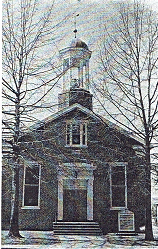
Christ Lutheran Church
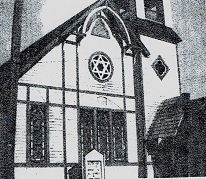

Church buildings from the past.
Excerpts from: "History of St.Paul United Methodist Church Manchester, PA" Margaret Swan 1982 |
Some pics are from Larry Good.
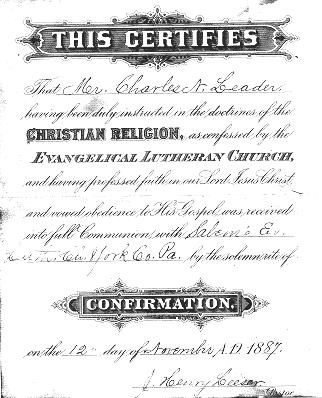
These items were found in the 1850 home of 22 High St Manchester Pa. The 1887 confirmation paper and brown book were found in the wall. A board, under a dining room floor shelving, was lifted and a hole with a crawl space was discovered. In that earth hole was found the above items, the shoe on the right and some of the glass. Was this a hidding place?
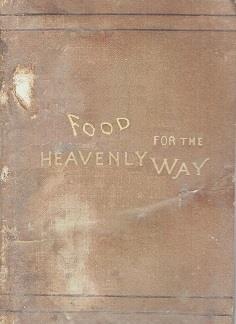
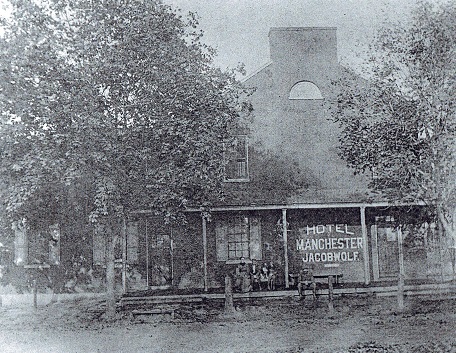
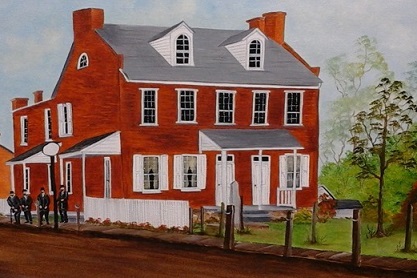
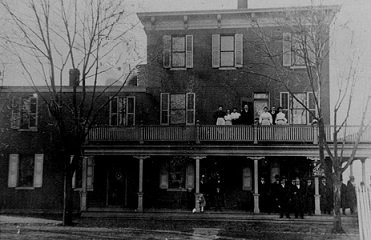
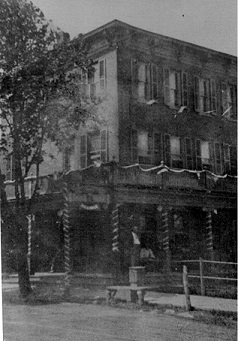

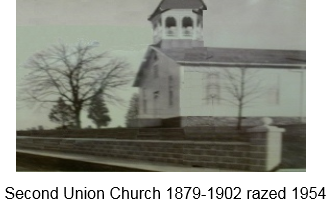
Mennonite Meeting House 1810
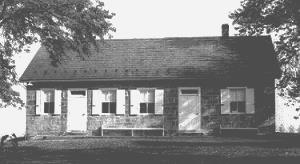
NeyChip would love
to hear from you.
NeyChip@gmail.com
to hear from you.
NeyChip@gmail.com
